"Emka": the history of the service car officer (part 1)
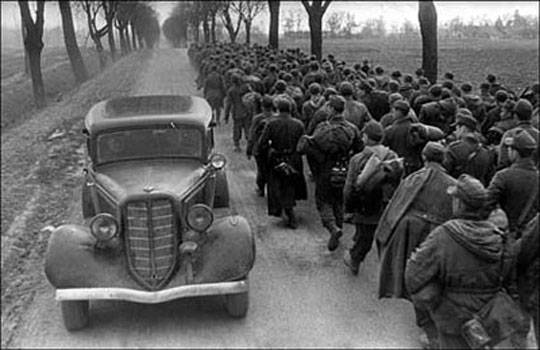
The headquarters vehicle M-1 is driving towards a convoy of German prisoners of war. Photo from the site http://denisovets.ru
Today's troops are inconceivable without command vehicles. Commander Tanks, commander armored personnel carriers, commander cars ... The latter entered the practice earlier than anyone - a little over a century ago, as soon as industry mastered the conveyor production of cars, and the army assessed their capabilities. Then it became clear that the familiar commander’s horse would gradually give way to the commander’s car.
But this did not happen immediately, but in the Soviet Union, which had lost almost two decades to cope with the consequences of the First World and Civil Wars, and even later. Nevertheless, our army met the Great Patriotic War, having a very solid commander fleet. As of 22 June 1941, a half dozen thousand emocs served there. It was under such affectionate name that the first mass domestic car was known to drivers. And it was under him that she forever entered the Soviet history as one of the legendary symbols of the Great Patriotic War - along with the T-34 tank, Il-2 attack aircraft and the PPSh submachine gun.
Good, but not for our roads
However, M-1 owes its appearance to the army not to the army. The first domestic auto giant, the Nizhny Novgorod (later Gorky) Automobile Plant, was a licensed structure. The American automobile company Ford Motor Company played the most active role in its creation. For the USSR, the end of 20 — the beginning of 30 — was common practice: our country, which lost almost 90% of scientific, engineering and highly skilled workers in the first quarter of a century during wars and revolutions, needed such help from outside. Naturally, the first car models in 1932 that came off the assembly line in Nizhny Novgorod were licensed cars: the GAZ-AA truck was turned by Ford-AA, and the passenger phaeton (as the car with an open passenger body was called in terms of that time) Ford-A passenger car.
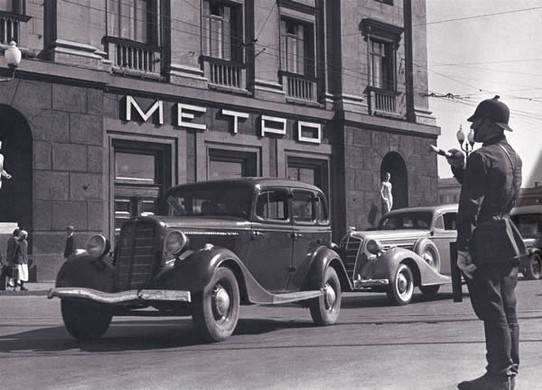
GAS M-1 first issues in Moscow. Photo from http://www.am02.ru
It was these two cars that became the first domestically produced cars that replaced the outdated cars produced before the war or accidentally got into the USSR. And there were enough of them: there were also cars of Russian production, and numerous cars that were still in service with the Russian imperial army, and found themselves in the country during the intervention, and bought for gold for the country in dire need of motor transport ... But they all had two significant drawbacks: extreme wear and tear and lack of spare parts that were literally worth their weight in gold. The Red Army felt this especially in its experience: the rapidly changing conditions of warfare required a serious fleet, and it was impossible to build it up without one’s production. So both GAZ-AA, the predecessor of the “Lorry”, and GAZ-A came in handy.
But if the truck can be adapted for use in any conditions, even the most severe, then an open passenger car was not the best choice for Russia. In addition, it was rapidly becoming obsolete, and in addition, it was very demanding of the qualifications of the staff - which, alas, the country was not rich. And because a year later, the new chief designer of GAZ, an outstanding Soviet engineer, a graduate of the Moscow Technical University Andrey Lipgart set himself a difficult task for himself and his subordinates: to create his own model that would meet the requirements and capabilities of domestic exploitation much better.
Simple, reliable, strong
By that time, the well-proven, but clearly morally obsolete Ford-A at the company's American factories replaced the much more modern Ford-B, and soon the Ford Model 18 with an eight-cylinder engine was created based on it. These models received a much wider range of bodies, among which there were completely closed ones - just what was required for the Russian conditions.
It was a good moment to, figuratively speaking, not to reinvent the wheel, but to master the already developed products, bringing it to fit the domestic capabilities and operating conditions. And since the existing license agreement implied the opportunity to receive a novelty for development on GAZ, she very soon got there.
But it would be unfair to say that the emka is just a converted Ford, even if it was released at a Soviet factory. Before the car went into the series, GAZ’s stellar design team seriously worked on its design - starting with Andrey Liphart, who held this position from 1933 to 1951 a year and during that time managed to launch 27 models in production. It was he who formulated the basic requirements for the development of the first mass passenger car of domestic construction - GAZ M-1. Moreover, he formulated in such a way that today they are absolutely not outdated!
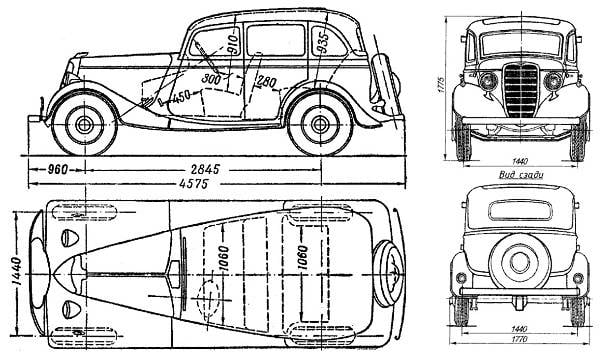
Drawings of the car GAZ-M-1. Photo from http://armedman.ru
That's what Andrei Lipgart demanded from himself and his subordinates - the designers Anatoly Krieger, Yuri Sorochkin, Lev Kostkin, Nikolai Mozokhin and their other colleagues. The new car had to be, firstly, to be strong and durable in all its parts when working in our road conditions; secondly, to have a high cross; thirdly, to have good dynamics; fourth, to be as economical as possible in the use of fuel; Fifthly, in terms of comfort, appearance and decoration, it is not inferior to the latest best American models of the mass type; and finally, sixthly, but not in the last, the design of the car should be simple and understandable even to low-skilled personnel, and care and adjustment should be simple and accessible to the driver of average qualification, without requiring mechanics.
From such a list of requirements, it’s completely understandable: GAZ did not design a mass passenger car for private use, but a vehicle for the national economy and the army. Hence, the requirements for increased maneuverability, and the emphasis on endurance (the operating conditions of emoc were both difficult for civilian and military service), and economical, and maintainability - as far as this could be achieved at that time and in those conditions.
Car "recruit"
Of all the above conditions, the “original”, that is, the “Ford” of the “B” model and the Model40, answered, perhaps, only two: good dynamics and comfort with decoration. Everything else needed to be rethought, relying on the experience of operating cars in the Soviet Union, which the American designers did not have. And the Soviet - was already. Indeed, behind the same Andrei Lipgart’s back there were years of work at NAMI, which became an excellent design school and showed what any domestic machine should prepare for.
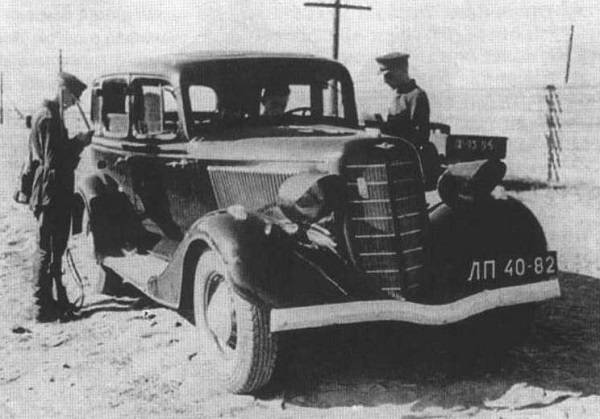
Verification of documents from passengers and the driver of the headquarters car M-1. Photo from www.drive2.ru
She was supposed to be a “recruit”, ready at any moment to go to active service. And the "American" was a sissy. What was worth only the transverse springs, because of which the suspension in the case of operation is not on asphalt (that is, almost always in Soviet conditions!) Became completely short-lived, weak friction dampers and spokes wheels. Other than the American model, the front axle design, the steering, and the engine mount had to be “floating” instead of a stiff, low-life when used outside of asphalt.
But the most important thing that the Soviet autocontractors had to do was create a new frame for their offspring that would provide the necessary rigidity and flexibility at the same time, because the car would have to be ridden in difficult conditions. As a result, the required rigidity of the frame was created by spars of the 150-millimeter profile, the reinforcement inserts of which created a box-shaped contour in front of the machine. And in the center of the frame, in contrast to the American prototype, a rigid cross-shaped crossbar appeared - it allowed the car to "spin" around the longitudinal axis, which was inevitable on the roads.
In a word, it would be more fair to say that the team of autoconstructors of GAZ created their car, based on the American license obtained. And all subsequent modifications of the emka, first of all the army ones, were their own gas development altogether, although they retained their external similarity with the original model.
"God grant everyone such a car!"
The experimental department of the Gorky Automobile Plant began work on adapting the new Fords to domestic conditions in the autumn of the 1933 of the year - immediately after the arrival of Andrey Lipgart to the position of chief engineer. By January, the 1934 of the year collected the first three experimental samples of the car, which received the M-1 index, that is, the "Molotovets-First". "Molotov" - in honor of Vyacheslav Molotov, whose name was GAZ. And why is the first - and so it is clear: they did not make such cars in our country before the “emka”. By the way, as the factory legend says, the workers of GAZ, who assembled the first prototypes, called the car “emblem”: they really liked what worked and didn’t want to call the novelty an official index in their working conversations.
The next two years were spent on working out the resulting structure and bring it to conveyor production. I had to do a lot, because the first three copies even outwardly differed from the usual “emka” look. Their wheels were still knitting, there were hatches on the sides of the bonnet, the radiator had a more labor-intensive and complexly shaped lining. All these "excesses" had to be eliminated in order to simplify and cheapen the mass production of the M-1. For the sake of this, they even went to make the body not completely metallic. Above the frame with the doors opening backwards in the direction of travel, were longitudinal wooden bars, on which a fixed dermantine roof was tied, painted together with the whole body.
Finally, by the beginning of 1936, all the preparatory work for the release of the emki was completed. I went to a series of new engine - a converted engine from GAZ-A: it became more powerful at 10 "horses", although it retained the same volume, got a lubrication system under pressure, a circulation cooling system (from the pump), an ignition timing automatic, a new carburetor like Zenit "with economizer and automatic air damper valve, which ensured stable operation of the engine in all modes, crankshaft with counterweights, as well as contact-oil air filter. So 16 March 1936, the first GAZ M-1, or emka, left the GAZ assembly line. And the next day, two new emki already stood on one of the Kremlin squares: the plant management decided to immediately show the goods face.
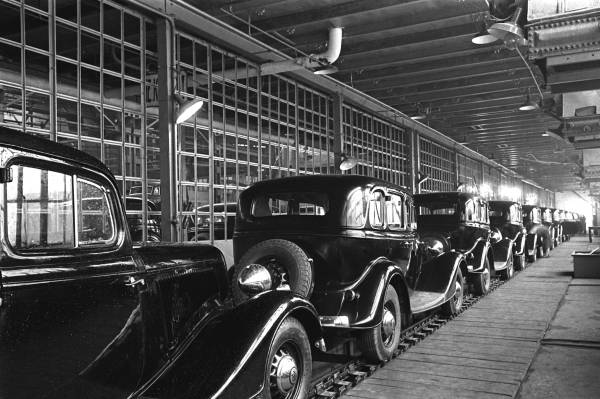
M-1 cars on the assembly line of the GAZ plant. Photo from the site http://www.aif.ru
The emki was examined by General Secretary of the Central Committee of the CPSU (b) Iosif Stalin, Chairman of the Council of People's Commissars Vyacheslav Molotov, People's Commissar of Heavy Industry Sergo Ordzhonikidze and People's Commissar of Defense Clement Voroshilov. The calculation of the factory workers was simple: approval from the top Soviet leadership practically guaranteed a good future for the new product. Two cars with more elegant than the Ford, lines of footpegs and wings, gleaming black lacquer, with a sloped grille, large vents and a thin red line on the board, emphasizing the body, clearly liked the first people of the country. In his memoirs, Andrei Lipgart writes that Stalin even summed up his acquaintance with the emkoy with such words: “May God grant each such car!”.
Well, about “everyone”, the all-powerful Soviet leader got a little excited: M-1 was not received for free sale. Since the production volume of the car was relatively small (if we evaluate the potential Soviet domestic car market), it was not sold, but distributed. And to receive in temporary, and moreover, in personal use "emk" was the same award, as an award or the Stalin award! Yes, they often went hand in hand, and the newly minted order bearers, especially those who were awarded for their labor exploits, often presented a new M-1 - so that they, by personal example, would emphasize the advantages of honest work for the benefit of the socialist homeland.
"Emka" goes to the army
Among the options in which the first years were produced M-1, there were taxis: then the car received a pre-installed taximeter. Still, most of the cars that left the assembly line were sent to the people's commissariats and distributed to the republican and regional administrations, as well as “trying on shirts”. It was the “emka” that became the first serial production vehicle of the Red Army - the vehicle with which the army met the Great Patriotic War.
Most of all "emok" served as a commander or staff cars in the infantry regiments of the Red Army. According to the pre-war staffing of 5 on April 1941 of the year, the list of vehicles of the regiment consisted of one passenger car - this was the M-1. According to the same staffing table, but already a rifle division, the total number of cars relying on it was 19 units. Most of the cars — five of them — were at the headquarters of the division, three of them were a howitzer artillery regiment, one each was in an artillery regiment and in each rifle regiment, and the rest got to the transport departments of various divisions. Taking into account the fact that, in total, before the beginning of the war, the Red Army included only 198 rifle divisions, it turns out that they included 3762 cars. And even if we assume that these were not always “emki”, which is unlikely, it turns out that only rifle divisions had at least three thousand GAZ M-1 vehicles. Although almost certainly the e-cards were all the cars that were counted - the others were simply nowhere to go, except to remain from ancient times.
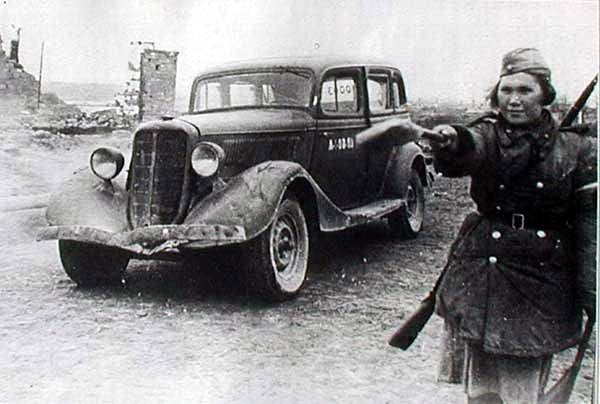
Car M-1 on the front of the road. Photo from http://carspravka.ru
But the higher from the rifle division, the more cars - which is understandable. According to the staff of the peacetime army field office from 13 September 1940, it was supposed to have 25 cars. The military mechanization department for the 1940 state of the year was 12 passenger cars, and the same amount was required to have a separate motorized brigade on the staff. In a word, everywhere in the pre-war states of the Soviet military units, where the point “passenger cars” is found, it is safe to replace these words with the word “emka”, without being afraid to make a big mistake.
But it will be necessary to add here all sorts of military newspapers, starting with divisional and ending with district newspapers, plus central military publications, plus military academies and other military educational institutions, plus military justice agencies, and so on and so forth. In addition, the emks received air force units (for example, in the state of wartime fighter aviation from 1937, 15 cars, and heavy bombers, 20), and the same vehicles were in their possession headquarters and fleet and flotilla control, where too, the total score was not in units, but in dozens ...
So it turns out that among the 10 500 cars - namely, the Red Army and the Red Fleet on the eve of World War II had such a number of M-1 machines - there is nothing surprising. After all, for the military of the time, when it came to official vehicles, the word “emka” was synonymous with a passenger car.
Продолжение следует ...
Information